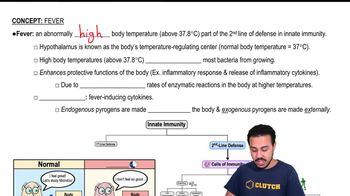Select all the false statements about fever.
a. It is generated by pyrogens.
b. It is an innate immune defense.
c. It is accompanied by a decrease in metabolism.
d. It can be reduced by anti-inflammatory drugs.
e. It can accompany inflammation.
 Verified step by step guidance
Verified step by step guidance



Select all the false statements about fever.
a. It is generated by pyrogens.
b. It is an innate immune defense.
c. It is accompanied by a decrease in metabolism.
d. It can be reduced by anti-inflammatory drugs.
e. It can accompany inflammation.
Which of the following is a chemical defense found in tears? Select all that apply.
a. Water
b. Lysozyme
c. Antimicrobial peptides
d. Neutrophils
Which of the following are formed elements of the blood? Select all that apply. (NCLEX/HESI/TEAS)
a. Platelet
b. Leukocyte
c. Plasma
d. Erythrocyte
e. Complement proteins
Which of the following would most directly reduce fever? Select all that apply. (NCLEX/HESI/TEAS)
a. Limiting the number of circulating white blood cells
b. Reducing eicosanoid production
c. Inhibiting pyrogenic cytokines
d. Stimulating the action of prostaglandins
e. Administering antihistamines
Which of the following would you expect to see in acute infection by a Gram-negative bacterium? Select all that apply. (NCLEX/HESI/TEAS)
a. Pyrexia
b. Decreased lymphocytes
c. Neutrophilic lymphocytosis
d. Decreased monocytes
e. Increased release of pro-inflammatory cytokines
Which of the following would you expect to see increased in circulation in a patient suffering from allergies? Select all that apply. (NCLEX/HESI/TEAS)
a. <IMAGE>
b. <IMAGE>
c. <IMAGE>
d. <IMAGE>
e. <IMAGE>